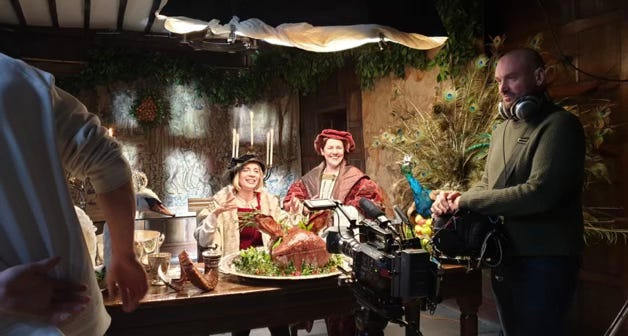The curious history of the FORK
And what it reveals about your social class!
I really love the history of ordinary objects. Sometimes something completely utilitarian and taken-for-granted can open up a little window for us into the lost worlds of the past.
The oldest surviving object among the British Crown Jewels is the twelfth-century Coronation Spoon. I’m amused by the fact you can buy a replica of it in the Historic Royal Palaces shop, just in case you want to do a bit of anointing with holy oil at home.
Spoons have existed since Norman times, then, so have knives, but not so the fork. This is a description of the duties of a medieval waiter: ‘put the salt on the right hand of your lord,’ and ‘on his left a trencher or two’ (a trencher’s basically a wooden plate). ‘On their left a knife, then white rolls, and beside, a spoon folded in a napkin.’
No fork!
This lord would use his fingers, his spoon and bits of his white bread to get his food into his mouth. He’d wear that napkin over his shoulder, probably, to protect his clothes, and easily to wipe his fingers. (I noticed with approval that they got the napkins right in the filming of Wolf Hall, the subject of last week’s post.)
When we get to the sixteenth century, however, Henry VIII was one of the first people in Britain known to use a fork. Not for his meat, though, which he’d still cut and also spear up with his knife. His fancy little silver ‘suckett fork’ was used for dessert: candied fruit (or sucketts) little jellies, almond creams, that sort of thing.
Nor was it a fork like you’d recognise, because it only had two prongs. Nor did it really catch on.
When in the next century the Jacobean Thomas Coryatt came back from a trip to Italy, he was excited to report that the foreigners he’d met were really into forks. But his news got a cold welcome. ‘We need no little forks’ complained Nicholas Breton in 1618, ‘to make hay with our mouths.’ Newfangled, un-British nonsense!
But in fact, by the end of the seventeenth century, we’d been well and truly won over. Charles II and many of his courtiers spent nearly a decade in continental exile during Oliver Cromwell’s Republic. On their return, they brought with them the forks they’d got used to across the Channel. And people’s napkins, in consequence of the neater eating, descended from people’s shoulders and down onto their laps where – in posh restaurants at least – you might still find them today.
Georgian forks began to have the third prong or tine we’re used to, but the fork’s real glory-day was the nineteenth century.
In this period, there was a big switchover in the way food was served. The old custom was to bring all the food to the table at once, in big serving dishes, for people to help themselves. Bit like a buffet.
The new custom, called service à la Russe, saw individual helpings dished up away from the table, and placed before each diner on separate plates. The modern idea of multiple ‘courses’ was born.
Now hosts started to hanker after clean knives and forks for each course. Naturally, in a consumerist age, this was a wonderful new opportunity to go shopping. Cake fork? Fish knife? Fruit knife? By Edwardian times, a dinner party for ten might involve 500 separate pieces of cutlery and crockery.
Nevertheless, in one of those sneaky British little nuances of class, it was actually cooler not to have too many forks.
If your family had been wealthy in the eighteenth century, you’d stick to using your Georgian silver forks, rather than going down the nouveau riche route of acquiring all those flashy minor variations.
Too many forks, frankly, is vulgar.
At least according to that fine observer of twentieth-century British class graduations and manners, John Betjeman.
In his poem satirising the language of lower-middle-class people, superfluous forks come in for a kicking. ‘Phone for the fish knives, Norman,’ Betjeman begins:
'Phone for the fish knives, Norman,
As cook is a little unnerved;
You kiddies have crumpled the serviettes
And I must have things daintily served.’So, dear readers, make like Henry VIII. One fork each is quite enough.
Like this kind of thing? You might like my book If Walls Could Talk, An Intimate History of the Home, or this post here about how to be the best-dressed person in history.




By the Nineteenth Century, the fork was an implement whose tine had come.
Oh Lucy, that's super; you and Annie are a wonderful pair of Herstorians that are always a joy to see / listen to and read. Of course I've got Annie's latest book.
Really looking forward to this.